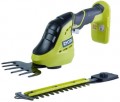Pole length
The length of the bar usually refers to the total length of the brush attachment or saw blade (see Attachments) supplied with the hedge trimmer. The
longer the tire, the longer the cut that the tool can make at a time. In general, it is believed that a short length is typical for entry-level tools, while professional ones are equipped with larger attachments. However, here you need to take into account that the choice depends not only on the scale, but also on the specifics of the intended work: long attachments are less maneuverable and less suitable for topiary trimming of bushes. In addition, the cost of a brush cutter also largely depends on this parameter.
Tooth pitch
The distance between the individual teeth of the shrub attachment (see "Tips") supplied with the tool. The
larger the pitch of the teeth, the easier the tool will cope with thick branches, however, the quality of the work will be quite rough. Conversely, more densely spaced teeth work "cleaner" but are less suited to tough conditions and large branches.
Stroke frequency
The frequency of movement of the teeth in bush or grass attachments (see "Tips"). The design of most of these tools is such that for one revolution of the engine, the teeth make one complete cycle of movement back and forth; therefore, the stroke rate is usually determined by the speed of rotation of the engine and is indicated in revolutions per minute.
It is believed that the quality of the tool’s work largely depends on this parameter: the more often the stroke, the cleaner the cut will be. Ratings up to 2200 rpm are usually typical for entry-level devices, up to 2800 rpm are average, and advanced models can have speeds of 3400 rpm and even higher.
Compatible batteries
The name of the battery that is compatible with the device. It helps to buy a spare or find a suitable one in case of a breakdown of the main one.
Noise level
Approximate noise level produced by the hedge trimmer in normal operation. This parameter allows you to evaluate how comfortable it will be to work with the tool: the lower the noise level, the less discomfort it causes for the operator and others, and the lower the likelihood that special hearing protection will be needed during operation. At the same time, note that loud noise is an inevitable side effect of high power — it would be too expensive and difficult to make a powerful and low-noise tool. In addition, this figure is only approximate. Firstly, different manufacturers may indicate it differently: for idling, for full speed, for half power, etc. Secondly, the actual volume of work may also differ from the claimed one due to the peculiarities of a particular situation: for example, working with thick branches leads to an increase in the load on the engine, which can also affect the noise level.
Another specific point is that the decibel used to measure this indicator is a non-linear value: an increase of 1 dB corresponds to an increase of 1.26 times, 3 dB — 2 times, etc. Therefore, to assess the loudness of work, it is easiest to use comparative tables. Here is one of the simplified versions of such a table for the range in which most modern hedge trimmers work:
65 dB — loud conversation at a distance of a metre;
70 dB — loud conversation of several people at the same distance;
75 dB — shout from the same distance;
80 dB — the ringin...g of a mechanical alarm clock, a loud cry at a distance of 1 m;
85 dB — loud screams at a distance of 1 m;
90 dB — heavy truck or freight car at a distance of 7 m;
95 dB — subway car at a distance of 7 m;
100 dB — noisy industrial shop.
Weight
The total weight of the brush cutter. Usually indicated for a fully equipped tool, with an attachment installed and, in the case of a petrol engine, a full tank of fuel; however, there may be exceptions. Usually, the relevant data is indicated in the official documentation.
This parameter is important, first of all, taking into account the fact that the tool during work will have to be kept on weight most of the time. Accordingly, the lighter the brush cutter, the longer you can work with it without interruption, the less often you have to rest. On the other hand, a large weight also has its advantages: a heavy tool is more stable and does not “tear out of hand” as much under high loads on the nozzle.

